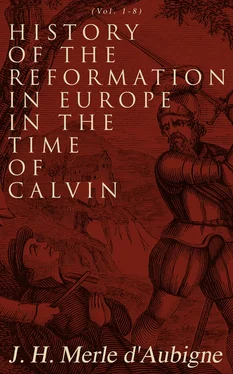Erelong another scene was enacted beyond the Alps. The miserable John of Savoy lay at Pignerol on his death-bed. Given during his life to the pleasures of the table and of debauchery, he was now paying the penalty of his misdeeds. He suffered from the gout, he was covered with filthy ulcers, he was little more than skin and bone. He had thought only of enjoying life and oppressing others; he had plotted the ruin of a city of which he should have been the pastor; he now received the wages of his iniquity. Near the bed where this prelate lay languishing stood his coadjutor, who had hastened from Geneva to Pignerol. With eyes fixed upon the dying man, Pierre sought to buoy him up with false hopes; but John was not to be deceived. Soon the dreaded moment approached; an historian, whom Romish writers quote habitually with favour, 303describes all that was horrible in the end of this great sinner. Hirelings surrounded the dying bishop, and turned their eyes from time to time on him and on the objects they might be able to carry off as soon as he was insensible. Pierre de la Baume contemplated the progress of the disease with ill-dissembled satisfaction, eagerly anticipating the moment when, relieved from his hypocritical cares, he would enter into possession of all that he had coveted for so many years. Jean Portier, the dying man’s secretary, the confidant of his successor, watched that criminal impatience, that sordid cupidity, and that perverse meanness, which he already hoped to turn to his advantage. The shadows of the victims of the expiring man were traced on the walls of the room by an avenging hand, and when at last the priests desired to administer extreme unction, he imagined they were covering him with blood. They presented him the crucifix; he seemed to recognise the features of Berthelier, and asked with a wild look: ‘Who has done that?’ Far from embracing with respect and submission this emblem of eternal salvation, he rejected it with horror, heaping foul abuses on it. Blasphemy and insult mingled with the foam that whitened his trembling lips. Thus wrote an author less Romanist, we perceive, than is imagined. 304Repentance succeeded despair in the guilty soul of the prelate before his death. Turning a last look on his adopted son, he said to him: ‘I wished to give the principality of Geneva to Savoy ... and to attain my object, I have put many innocent persons to death.’ The blood that he had shed cried in his ears: Navis, Blanchet, and Berthelier rose up before him. Pursued by remorse, weighed down by the fear of a Judge, he would have desired to save La Baume from the faults he had committed himself. ‘If you obtain this bishopric,’ continued he, ‘I entreat you not to tread in my footsteps. On the contrary, defend the franchises of the city.... In the sufferings I endure, I recognise the vengeance of the Almighty.... I pray to God for pardon from the bottom of my heart.... In purgatory ... God will pardon me!’ 305It is gratifying to hear this cry of an awakening conscience at the termination of a criminal life. Unfortunately Pierre de la Baume did not profit by this solemn advice. The bastard died after horrible sufferings, ‘inflicted by the divine judgment,’ says Bonivard, ‘and he went into the presence of the Sovereign to plead with those whose blood he had shed.’—‘At the time of his death, he was so withered,’ adds the prior of St. Victor, ‘that he did not weigh five and twenty pounds.’ The prophecy of Pécolat was fulfilled: Non videbit dies Petri. Instead of twenty-five years the episcopacy of John of Savoy had only lasted nine.
Geneva was about to change masters. The struggle which had characterised the episcopacy of John of Savoy could not fail to be renewed if, instead of a shepherd, the Genevese received a hireling. Who would come off victorious in this new combat? Would the old times be maintained; or, thanks to a prelate who understood the wants of the age and the nature of the Gospel, should we witness the commencement of a new era? There was little hope that it would be so. The episcopal see of Geneva, which gave the rank of temporal prince, was much coveted by nobles, and even, as we have seen, by members of the sovereign families. These worldly bishops thought only of getting rich and of living in pomp and pleasure, careless of the good government of the Church or of feeding their flock. The thrones of such princes could not but totter and fall erelong. Pierre de la Baume, certain good qualities notwithstanding, could not prevent this catastrophe; on the contrary, he accelerated it. He had wit and imagination; but was weak, vain, and inclined to the same habits of servility as his predecessor, ‘incapable,’ says an historian, ‘of comprehending any other happiness than sleeping well, after he had eaten and drunk well.’ 306
The bastard having breathed his last, Pierre, kneeling by the side of his bed, rose up a bishop. He took immediate steps to secure his new property from pillage, and on the 7th of February, 1522, wrote a letter to ‘his dearly beloved and trusty syndics, councillors, citizens, and community of Geneva,’ which gave no promise that the reign of truth would be witnessed during his episcopacy. He began with the falsehoods usual in such cases, and informed the Genevans that his predecessor had ‘made as holy an end as ever prelate did, calling upon his Creator and the Virgin Mary with his latest breath.’ He reminded them at the same time ‘of the great love and affection which John had felt while alive for them and for all his good subjects.’ ... ‘Witness the chestnut-tree at the bridge of Arve,’ said some. 307
A year elapsed before the new bishop came to Geneva. Was it from fear; or did his temporal occupations keep him away? It was probably the latter motive. He had to come to an understanding with the duke and the pope touching his episcopacy, and he visited Rome in order to obtain his briefs. At last, on the 11th of April, 1523, his solemn entry took place. 308A great multitude flocked together from all the surrounding districts. The syndics, the councillors, and the people went as far as the bridge of Arve to meet the bishop, who, accompanied by his gentlemen, priests and friends, and having by his side the Countess of Montrevel his sister-in-law, the Marquis of St. Sorlin his second brother, and two of his nephews, advanced ‘riding on a mule beautifully harnessed and gilt, and wearing a green hat, after the fashion of the bishops of Rome.’ The four syndics carried a handsome canopy over his head, which a pelting rain rendered very necessary. ‘More than a hundred horses crept at a snail’s pace before him.’ Four companies of archers, arquebusiers, bowmen, and spearmen marched by with firm steps. In every street of the city ‘young men well mounted, equipped, and accoutred, rode à l’albanaise.’ Dramas, farces, mysteries, games and pastimes were given in the open air in spite of the rain, and the Genevans were full of hope. It might have been said that this branch, so severely shaken and almost separated from the Roman papacy, was about to be restored. Geneva, by welcoming the bishop so cordially, seemed to be welcoming the pope who sent him. This was however in the year 1523. Luther had burnt the bull from Rome; he had said before the Diet of Worms, I cannot do otherwise . The Reformation was advancing with great strides at Wittemberg, and was spreading over all Germany. And yet it was just at this time that Geneva received a Roman bishop almost with enthusiasm; but if the energetic city should be disappointed in its expectations, we shall see it rise up against all the framework of Rome and overthrow it without leaving a single piece in its place.
For the moment men indulged in the most flattering hopes. La Baume bore a tree (in German baum ) on his shield; the Genevese presented him a poem, the first lines of which ran thus:
Читать дальше







![Hubert Bancroft - The Native Races [of the Pacific states], Volume 5, Primitive History](/books/749157/hubert-bancroft-the-native-races-of-the-pacific-s-thumb.webp)




